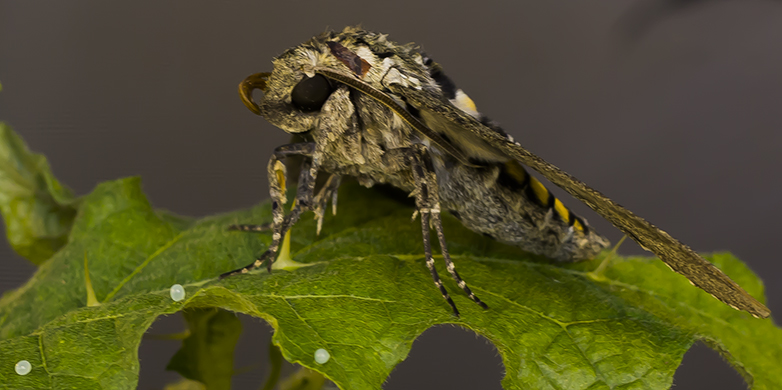Tritrophic interactions

A primary focus of our research is on the role of chemistry in mediating ecological interactions among plants and other organisms, including insect herbivores and their natural enemies. In addition to exploring how plant nutritional and defense chemistry mediates plant-herbivore interactions, our group is particularly interested in understanding the signaling functions or plant-derived olfactory cues.
Plants dominate the biomass of terrestrial ecosystems and engage in continuous gas exchange with the surrounding atmosphere, creating a rich olfactory landscape for other organisms, especially insects. Furthermore, because patterns of plant volatile emissions often vary systematically in response to environmental stimuli, including herbivore feeding damage, plant volatiles can potentially convey a great deal of information about the status of emitting plants to receiving organisms. For example, some of our past work has shown that specialist parasitoids can recognize and selectively respond to the olfactory signatures of plants attacked by the particular species on which they prey.
A major focus of our current research efforts is on understanding how volatile cues mediate ecological interactions in complex, real-world environments and the ecological and evolutionary implications of variation in chemical signaling phenotypes within and among plant populations. This work also aims to provide knowledge relevant for the development of novel management strategies for agricultural pests informed by a sophisticated understanding of underlying ecological mechanisms.
Selected publications:
Helms, AM, CM De Moraes, A Tröger, HT Alborn, W Francke, JF Tooker & MC Mescher. (2017) Identification of an insect-produced olfactory cue that primes plant defenses.
Nature Communications 8: 337 external pageDOIcall_made
Kariyat, RR, AG Stephenson, CM De Moraes & MC Mescher. (2017) Plant spines deter herbivory by restricting caterpillar movement.
Biology Letters 13 external pageDOIcall_made
McCormick AC, E Grosse-Wilde, D Wheeler, MC Mescher, BS Hansson & CM De Moraes. (2017) Comparing the Expression of Olfaction-Related Genes in Gypsy Moth (Lymantria dispar) Adult Females and Larvae from One Flightless and Two Flight-Capable Populations.
Frontiers of Ecology and Evolution external pageDOIcall_made
Mescher MC & CM De Moraes. (2015) The role of plant sensory perception in plant-animal interactions.
Journal of Experimental Botany. 66 (2): 425-433.
Helms, A.M., De Moraes, C.M., Mescher, M.C., Tooker, J.F. (2014) The volatile emission of Eurosta solidaginis primes herbivore-induced volatile production in Solidago altissima and does not directly deter insect feeding.
BMC Plant Biology 14(1): 173
Kariyat, R.R., Balogh, C.M., Moraski, R.P., De Moraes, C.M., Mescher, M.C., Stephenson, A.G. (2013) Constitutive and herbivore-induced structural defenses are compromised by inbreeding in Solanum carolinense (Solanaceae).
American Journal of Botany 100(6): 1014-1021.
Kariyat, R.R., Mauck, K.E., Balogh, C.M., Stephenson, A.G., Mescher, M.C., De Moraes, C.M. (2013) Inbreeding in horsenettle (Solanum carolinense) alters night-time volatile emissions that guide oviposition by Manduca sexta moths.
Proceedings of the Royal Society B: Biological Sciences 280(1757): 20130020
Helms, A.M., De Moraes, C.M., Tooker, J.F., Mescher, M.C. (2013) Exposure of Solidago altissima plants to volatile emissions of an insect antagonist (Eurosta solidaginis) deters subsequent herbivory.
Proceedings of the National Academy of Sciences 110(1): 199-204.
Kariyat, R.R., Mauck, K.E., De Moraes, C.M., Stephenson, A.G., Mescher, M.C. (2012) Inbreeding alters volatile signaling phenotypes and influences tri-trophic interactions in horsenettle (Solanum carolinense L.).
Ecology Letters 15(4): 301-309.
Kariyat, R.R., Scanlon, S.R., Mescher, M.C., De Moraes, C.M., Stephenson, A.G. (2011) Inbreeding depression in Solanum carolinense (Solanaceae) under field conditions and implications for mating system evolution.
PLoS One 6(12): e28459.
Delphia, C.M., Rohr, J.R., De Moraes, C.M., Stephenson, A.G., Mescher, M.C. (2009) Effects of genetic variation and inbreeding on volatile production in a field population of horsenettle.
International Journal of Plant Sciences 170(1): 12-20.
Tooker, J.F., De Moraes, C.M. (2009) A gall-inducing caterpillar species increases essential fatty acid content of its host plant without concomitant increases in phytohormone levels.
Molecular Plant-Microbe Interactions 22(5): 551-559.
Tooker, J.F., Rohr, J.R., Abrahamson, W.G., De Moraes, C.M. (2008) Gall insects can avoid and alter indirect plant defenses.
New Phytologist 178(3): 657-671.
